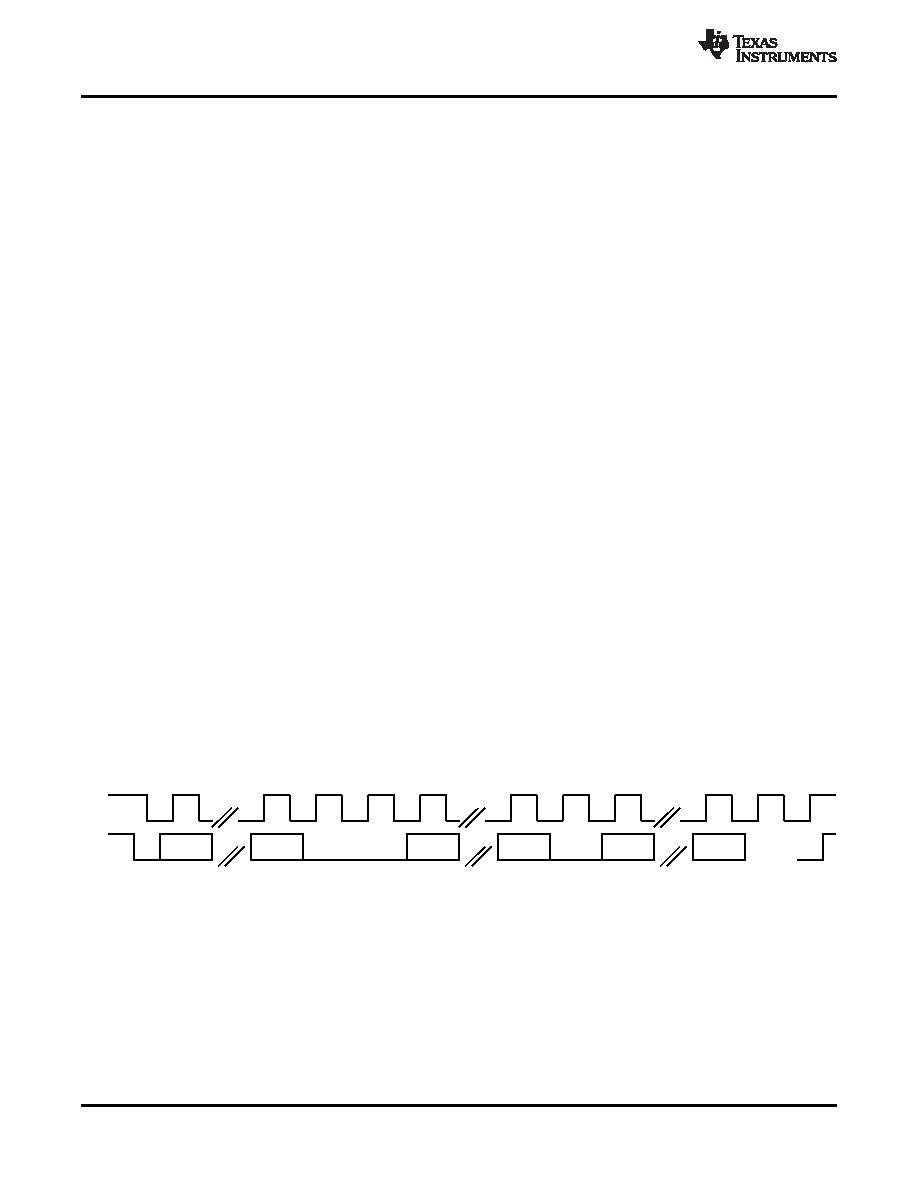- 您现在的位置:买卖IC网 > PDF目录98253 > TLV320AIC3107IRSBR (TEXAS INSTRUMENTS INC) 2 CHANNEL, AUDIO AMPLIFIER, PQCC40 PDF资料下载
参数资料
| 型号: | TLV320AIC3107IRSBR |
| 厂商: | TEXAS INSTRUMENTS INC |
| 元件分类: | 音频/视频放大 |
| 英文描述: | 2 CHANNEL, AUDIO AMPLIFIER, PQCC40 |
| 封装: | 5 X 5 MM, 0.40 MM PITCH, GREEN, PLASTIC, WQFN-40 |
| 文件页数: | 13/99页 |
| 文件大小: | 1474K |
| 代理商: | TLV320AIC3107IRSBR |
第1页第2页第3页第4页第5页第6页第7页第8页第9页第10页第11页第12页当前第13页第14页第15页第16页第17页第18页第19页第20页第21页第22页第23页第24页第25页第26页第27页第28页第29页第30页第31页第32页第33页第34页第35页第36页第37页第38页第39页第40页第41页第42页第43页第44页第45页第46页第47页第48页第49页第50页第51页第52页第53页第54页第55页第56页第57页第58页第59页第60页第61页第62页第63页第64页第65页第66页第67页第68页第69页第70页第71页第72页第73页第74页第75页第76页第77页第78页第79页第80页第81页第82页第83页第84页第85页第86页第87页第88页第89页第90页第91页第92页第93页第94页第95页第96页第97页第98页第99页

DA(6)
DA(0)
RA(7)
RA(0)
D(7)
D(0)
Start
(M)
7-bit Device Address
(M)
Write
(M)
Slave
Ack
(S)
8-bit Register Address
(M)
Slave
Ack
(S)
8-bit Register Data
(M)
Stop
(M)
Slave
Ack
(S)
SDA
SCL
(M) => SDA Controlled by Master
(S) => SDA Controlled by Slave
SLOS545C – NOVEMBER 2008 – REVISED MARCH 2009 .............................................................................................................................................. www.ti.com
Communication on the I2C bus always takes place between two devices, one acting as the master and the other
acting as the slave. Both masters and slaves can read and write, but slaves can only do so under the direction of
the master. Some I2C devices can act as masters or slaves, but the TLV320AIC3107 can only act as a slave
device.
An I2C bus consists of two lines, SDA and SCL. SDA carries data; SCL provides the clock. All data is transmitted
across the I2C bus in groups of eight bits. To send a bit on the I2C bus, the SDA line is driven to the appropriate
level while SCL is LOW (a LOW on SDA indicates the bit is zero; a HIGH indicates the bit is one). Once the SDA
line has settled, the SCL line is brought HIGH, then LOW. This pulse on SCL clocks the SDA bit into the
receivers shift register.
The I2C bus is bidirectional: the SDA line is used both for transmitting and receiving data. When a master reads
from a slave, the slave drives the data line; when a master sends to a slave, the master drives the data line.
Under normal circumstances the master drives the clock line.
Most of the time the bus is idle, no communication is taking place, and both lines are HIGH. When
communication is taking place, the bus is active. Only master devices can start a communication. They do this by
causing a START condition on the bus. Normally, the data line is only allowed to change state while the clock
line is LOW. If the data line changes state while the clock line is HIGH, it is either a START condition or its
counterpart, a STOP condition. A START condition is when the clock line is HIGH and the data line goes from
HIGH to LOW. A STOP condition is when the clock line is HIGH and the data line goes from LOW to HIGH.
After the master issues a START condition, it sends a byte that indicates which slave device it wants to
communicate with. This byte is called the address byte. Each device on an I2C bus has a unique 7-bit address to
which it responds. (Slaves can also have 10-bit addresses; see the I2C specification for details.) The master
sends an address in the address byte, together with a bit that indicates whether it wishes to read from or write to
the slave device.
Every byte transmitted on the I2C bus, whether it is address or data, is acknowledged with an acknowledge bit.
When a master has finished sending a byte (eight data bits) to a slave, it stops driving SDA and waits for the
slave to acknowledge the byte. The slave acknowledges the byte by pulling SDA LOW. The master then sends a
clock pulse to clock the acknowledge bit. Similarly, when a master has finished reading a byte, it pulls SDA LOW
to acknowledge this to the slave. It then sends a clock pulse to clock the bit.
A not-acknowledge is performed by simply leaving SDA HIGH during an acknowledge cycle. If a device is not
present on the bus, and the master attempts to address it, it will receive a not
acknowledge because no device
is present at that address to pull the line LOW.
When a master has finished communicating with a slave, it may issue a STOP condition. When a STOP
condition is issued, the bus becomes idle again. A master may also issue another START condition. When a
START condition is issued while the bus is active, it is called a repeated START condition.
The TLV320AIC3107 also responds to and acknowledges a General Call, which consists of the master issuing a
command with a slave address byte of 00H.
Figure 16. I2C Write
20
Copyright 2008–2009, Texas Instruments Incorporated
Product Folder Link(s): TLV320AIC3107
相关PDF资料 |
PDF描述 |
|---|---|
| TLV320AIC3107YZFR | 2 CHANNEL, AUDIO AMPLIFIER, PBGA42 |
| TLV320AIC3110IRHBR | AUDIO AMPLIFIER, PQCC32 |
| TLV320AIC3110IRHBT | AUDIO AMPLIFIER, PQCC32 |
| TLV320AIC3111IRHBT | AUDIO AMPLIFIER, PQCC32 |
| TLV320AIC3111IRHBR | AUDIO AMPLIFIER, PQCC32 |
相关代理商/技术参数 |
参数描述 |
|---|---|
| TLV320AIC3107IRSBT | 功能描述:接口—CODEC Low Pwr Stereo CODEC RoHS:否 制造商:Texas Instruments 类型: 分辨率: 转换速率:48 kSPs 接口类型:I2C ADC 数量:2 DAC 数量:4 工作电源电压:1.8 V, 2.1 V, 2.3 V to 5.5 V 最大工作温度:+ 85 C 安装风格:SMD/SMT 封装 / 箱体:DSBGA-81 封装:Reel |
| TLV320AIC3107IYZFR | 功能描述:接口—CODEC Low-Pwr Stereo CODEC RoHS:否 制造商:Texas Instruments 类型: 分辨率: 转换速率:48 kSPs 接口类型:I2C ADC 数量:2 DAC 数量:4 工作电源电压:1.8 V, 2.1 V, 2.3 V to 5.5 V 最大工作温度:+ 85 C 安装风格:SMD/SMT 封装 / 箱体:DSBGA-81 封装:Reel |
| TLV320AIC3107IYZFT | 功能描述:接口—CODEC Low-Pwr Stereo CODEC RoHS:否 制造商:Texas Instruments 类型: 分辨率: 转换速率:48 kSPs 接口类型:I2C ADC 数量:2 DAC 数量:4 工作电源电压:1.8 V, 2.1 V, 2.3 V to 5.5 V 最大工作温度:+ 85 C 安装风格:SMD/SMT 封装 / 箱体:DSBGA-81 封装:Reel |
| TLV320AIC3107YZFR | 制造商:TI 制造商全称:Texas Instruments 功能描述:LOW-POWER STEREO CODEC WITH INTEGRATED MONO CLASS-D SPEAKER AMPLIFIER |
| TLV320AIC3110 | 制造商:TI 制造商全称:Texas Instruments 功能描述:Low-Power Audio Codec With Audio Procsessing and Stereo Class-D Speaker Amplifier |
发布紧急采购,3分钟左右您将得到回复。